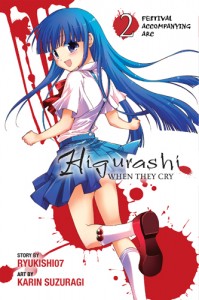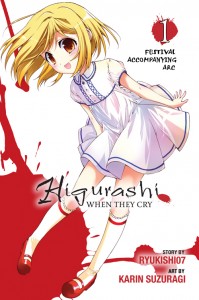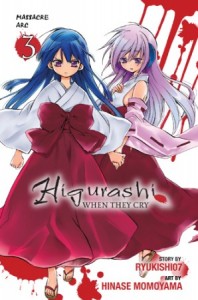Story by Ryukishi07; Art by Karin Suzuragi. Released in Japan as “Higurashi no Naku Koro ni: Matsuribayashi-hen” by Square Enix, serialized in the magazine Gangan Joker. Released in North America by Yen Press.
As I’ve been following the Higurashi manga, I’ve also been slowly going through the original visual novel, which MangaGamer has released here in North America (don’t look for their site – Higurashi is their token ‘not porn’ title). I just happen to be at the appropriate place in the novel as I am in the manga, so am able to compare them even more. It’s not clear how closely Ryukishi07 checked the content of the manga with the Higurashi artists – I know he’s very involved with the Umineko manga, particularly the final volumes, to correct certain issues with the novels – but certainly the manga glosses over a lot, being a sort of “greatest hits” compared to the deep immersion of the original. That said, where the manga does succeed is in the emotion. Be it heartwarming, sad tears, or dull horror, the manga delivers the goods here.
Nothing better demonstrates the difference between the two than the fate of Rika’s mother. The visual novel has this scene from the perspective of Ooishi, who is at the Festival waiting to see if anyone is killed. He’s on hand for the death of Rika’s father, made to look like a heart attack, and tries to follow the group back to the Irie Clinic but is hamstrung by traffic. Thus, we only hear that the wife is later found missing, supposedly having drowned herself in the swamp with a suspicious letter left behind. The manga, on the other hand, follows Rika’s mother. Rika’s mom has always been fairly high-strung from what little we’ve seen of her. It’s not hard to figure out why… Rika must be an amazingly difficult child to bring up. And what with the clinic using her as a guinea pig, and her father basically going along with it, her nerves just stretch to the breaking point. As such, she is ill-equipped to deal with Takano.
Takano remains fascinating, and though I think the visual novel does a better job of showing that a lot of this is Hinamizawa Syndrome rather than “lulz, I’m evil like that”, there’s enough here to keep everyone happy. Notably, for the sake of her research, she grovels at the feet of Rika’s parents, and when that fails, seems genuinely at a loss until Okonogi suggests “taking care of” Rika’s parents. Murder comes as a surprise to her… but once it’s in her head, she doesn’t hold back, as Rika’s parents instantly make the transition from “people” to “research subjects”. As such, she can easily justify using Rika’s mother as a live test subject. The murder is terrifying, and does not remotely hold back, with blood flying everywhere and Takano’s insane rictus grin it’s straight out of an Italian horror film.
Later on, Takano faces an even bigger setback when her mentor dies, and it’s shown that he was basically the only thing keeping her project going. Higurashi has a very realistic and cynical take on the Japanese political system and how power-grabbing it can be, particularly in the early 80s when this takes place. Takano once again has everything almost crumble around her, and it becomes apparently that even though she’s the source of all of Rika’s misery, she herself is being manipulated throughout this story, not just by Okonogi, but also a new faction who wants to use her in order to facilitate their own rise to power. If it works, great. If she dies, meh. And it’s clear the Mountain Hounds work for them, not Rika *or* Takano. Honestly, those two really have so much in common. They should talk over a nice cup of tea when this is over.
The visual novel goes into great detail on the pasts of most of the characters, and the manga manages to include some of it – Okonogi’s mourning for his father, and meeting his mentor after WWII shows why things starting with that guy’s death have led to his own obsession, even if it’s misdirected at the Sonozakis. Speaking of the Sonozakis, we see Mion’s grief and anger over Satoshi’s disappearance (Shion is carefully absent here), and her grandmother doing her best to bring “new blood” into the town while still trying to look old and crotchety. That new blood is the Maebara family, with Keiichi trying to start over after the BB gun incident. Rika and Hanyuu are at their most blatant here, with Rika actively showing she knows who they are and relying on people not realizing she’s living the same life over and over again so they laugh it off.
We also see Hanyu’s past, several hundred years ago. She really is a supernatural being, and her earnest attempts to stop the violence between the two tribes occupying Onigafuchi is heartwarming. I do think the drama needed more time to develop – as it is, it’s not as effecting simply as it goes by so fast – Hanyu gets her own daughter to kill her with a giant sword, which should have been given more weight. But then, Hanyu in general is the most problematic character of Higurashi’s so this is likely appropriate.
There are a few other things I felt didn’t work. Given how much Rika is using her past knowledge to make events work for her, her memories “catching up” with her at the end isn’t explained well enough, and seems to be awkwardly shoehorned in so there can be a cliffhanger. Also, four years pass between the start and end of this volume, yet the kids – all growing like weeds, one would think – look exactly the same in 1980 as they do in 1983. (The visual novel has a similar issue – the sprites never change.) More realism, please.
So now, all the pieces are in place – even Akasaka is having memories of a past life where his wife died and Rika was slaughtered, and is prepared to make his way to Hinamizawa immediately. Will all this be enough to defeat Takano and the forces that are manipulating her? And will Shion ever show up in this again? We’ll find out in January. In the meantime, this is still a very good adaptation with a lot of tragic and emotional scenes.



